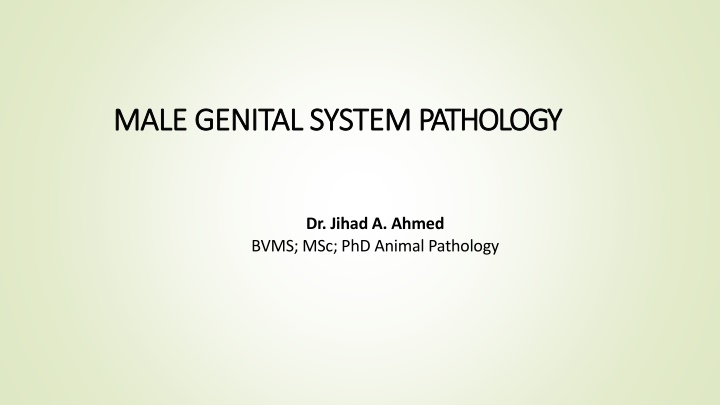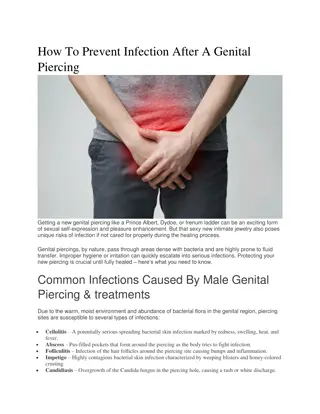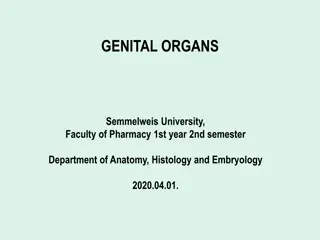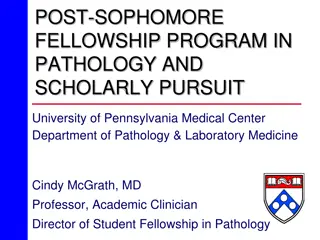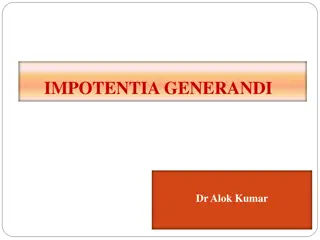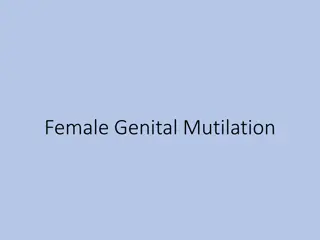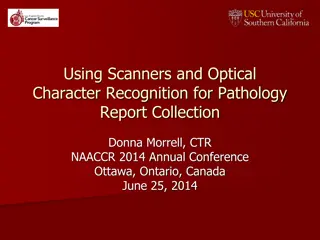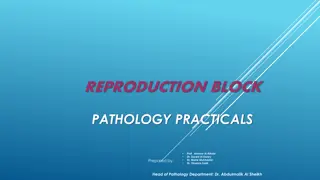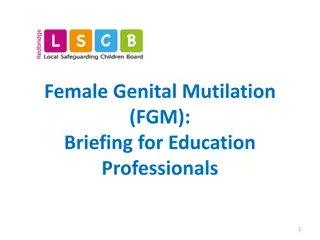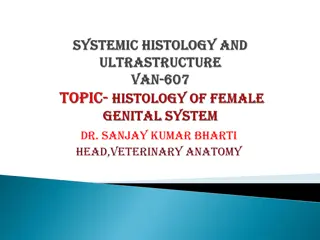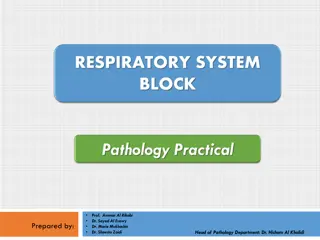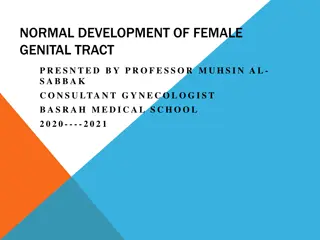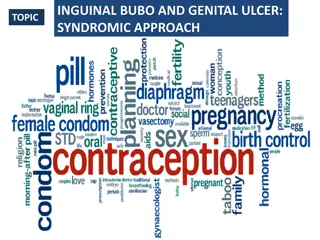MALE GENITAL SYSTEM PATHOLOGY
The male genital system includes the testes, which produce sperm and male hormones. Learn about the anatomy of the testes, their descent from the abdominal wall to the scrotum, and the blood supply and lymphatic drainage of the testis.
Download Presentation

Please find below an Image/Link to download the presentation.
The content on the website is provided AS IS for your information and personal use only. It may not be sold, licensed, or shared on other websites without obtaining consent from the author.If you encounter any issues during the download, it is possible that the publisher has removed the file from their server.
You are allowed to download the files provided on this website for personal or commercial use, subject to the condition that they are used lawfully. All files are the property of their respective owners.
The content on the website is provided AS IS for your information and personal use only. It may not be sold, licensed, or shared on other websites without obtaining consent from the author.
E N D
Presentation Transcript
MALE GENITAL SYSTEM MALE GENITAL SYSTEM PATHOLOGY PATHOLOGY Dr. Jihad A. Ahmed BVMS; MSc; PhD Animal Pathology
Anatomy of the testes. The testes (testicles) are the male gonads, paired ovoid reproductive glands that produce sperms (spermatozoa) and male hormones, primarily testosterone. The testes are suspended in the scrotum by the spermatic cords, with the left testis usually suspended (hanging) more inferiorly than the right testis. The epididymis is attached to the posteroinferior surface of the testes, this is important in distinguishing between swellings of the two parts.
Anatomy of the testes. The surface of each testis is covered by the visceral layer of the tunica vaginalis, except where the testis attaches to the epididymis and spermatic cord. The tunica vaginalis is a closed peritoneal sac partially surrounding the testis, which represents the closed-off distal part of the embryonic processus vaginalis. The visceral layer of the tunica vaginalis is closely applied to the testis, epididymis, and inferior part of the ductus deferens.
Continued. The testes have a tough fibrous outer surface, the tunica albuginea, that thickens into a ridge on its internal, posterior aspect as the mediastinum of the testis. From this internal ridge, fibrous septa extend inward between lobules of minute but long and highly coiled seminiferous tubules in which the sperms are produced. The seminiferous tubules are joined by straight tubules to the rete testis (L. rete, a net), a network of canals in the mediastinum of the testis.
Continued. During its development, each testis descends from the posterior abdominal wall to the scrotum, carrying with it a covering layer of peritoneum which forms the tunica vaginalis, a closed serous cavity around the testis. Blood vessels and lymphatics enter and leave the testis on its posterior surface at the hilum, which is not covered by tunica vaginalis. The descent from the abdominal wall starts by the 7thweek. By the 12th week, the testis is in the pelvis, and by 28 weeks (7th month), it lies close to the developing deep inguinal ring. The testis begins to pass through the inguinal canal during the 28th week and takes approximately 3 days to traverse it. Approximately 4 weeks later, the testis enters the scrotum
Continued. Blood is supplied by the spermatic artery, a branch of the aorta, which passes along the spermatic cord. The venous return surrounds the spermatic artery as a network of intercommunicating veins, the pampiniform plexus. This plexus becomes the main testicular vein which, on the right side, drains to the inferior vena cava and, on the left, joins the left renal vein. Lymphatic drainage of the testis is to the iliac and para-aortic lymph nodes.
Robbins and Cotran, Atlas of Pathology, 3rdedition, Page 310
Histology of the testes. The seminiferous tubules are formed of a lamellar connective tissue membrane. In the adult, the cells lining the seminiferous tubules are of 2 types: 1. Spermatogonia or germ cells which produce spermatocytes (primary and secondary), spermatids and mature spermatozoa.
Continued. 2. Sertoli cells which are larger and act as supportive cells to germ cells, they secrete androgen binding protein (ABP), which keeps a high concentration of testosterone in the germ cell environment. The seminiferous tubules have several layers of cells; the outermost layer consists the Spermatogonia, these divide to form the next layer i.e. of primary spermatocytes these divide to form the secondary spermatocytes
Continued. The fibrovascular stroma present between the seminiferous tubules contains varying number of interstitialcells of Leydig. Leydig cells have abundantcytoplasm containing lipid granules and elongated Reinke s crystals. These cells are the main source of testosterone and other androgenic hormones in males.
The location of the testes in the scrotum is important for sperm production, which is optimal at 2 C to 3 C below body temperature (35 C to 37.4 C). Two mechanisms maintain the temperature of the testes at a level consistent with sperm production. One is the pampiniform plexus of testicular veins that surround the testicular artery.This plexus absorbs heat from the arterial blood, cooling it as it enters the testes. The other is the dartos and cremaster muscles, which respond to decreases in testicular temperature by moving the testes closer to the body
Robbins and Cotran, Atlas of Pathology, 3rdedition, Page 311
Congenital anomalies of the testis. Cryptorchidism. Cryptorchidism is a complete or partial failure of the intra-abdominal testes to descend into the scrotal sac and is associated with testicular dysfunction and an increased risk of testicular cancer. Testicular descent occurs in two morphologically and hormonally distinct phases;
During the first transabdominal, phase, the testis comes to lie within the lower abdomen or brim of the pelvis. This phase is believed to be controlled by a hormone called m llerian inhibiting substance. In the second inguinoscrotal, phase, the testes descend through the inguinal canal into the scrotal sac. This phase is androgen-dependent and is possibly mediated by androgen-induced release of calcitonin gene related peptide from the genitofemoral nerve.
Although testes may arrest anywhere along their pathway of descent, the most common site is in the inguinal canal; arrest within the abdomen is uncommon, accounting for approximately 5% to 10% of cases. Even though testicular descent is controlled by hormonal factors, cryptorchidism is only rarely associated with a well-defined hormonal disorder. This condition is unilateral in most cases, however, 25% of the cases are bilateral.
Morphology Gross The testis is small, fibrotic and firm; Appears pale white on cut section. Microscopy These changes start within the 2ndyear,and its marked by arrested germ cell development. Hyalinization and thickening of the basement membrane ProminentLeydig cells.
INFLAMMATORY CONDITIONS OF THE TESTES. Is acute or chronic inflammation of the epididymisand the testes. Commonly related to infections of the urinary tracti.e. cystititis, urthritis or prostititis, the microorganisms get to the epididymis through the vas deferens or the lymphatics. oInflammation of the testis is termed as orchitis and of epididymis is called as epididymitis; the latter being more common. A combination epididymo-orchitis may also occur. Non-specific epididymitis and orchitis.
neutrophils. - In the early stages the infection is limited to the interstial tissue however, in the later stages, it may spread to involve the tubules and progress to formation of an abscess or complete suppurative necrosis of the entire epididymis. - From the epididymis,the reaction spreads to the testis to evoke a similar response. Morphology Gross - In the acute stages, testis are firm, swollen (due to edema) and congested. - In cases of gonorrhea, there may be multiple abscesses. - In chronic cases, the testis may become atrophic and fibrotic. Microscopic - Congestion,edema and diffuse infiltrationof
Granulomatous(Autoimmune) orchitis This idiopathic form of orchitis mainly affects the middle aged men, who present with a moderately tender testicular mass and sometimes with fever. May appear suddenly as a painless swelling similar to testicular tumor. It is a type of Type IV hypersensitivity reaction with a non-caseating granuloma.
Morphology. Gross oAffected testis is enlarged with a thickened tunica. The cut surface is greyish-white to tan-brown. Microscopic oNon-caseating granulomas that are restricted to the seminiferous tubules. The granuloma is composed of epithelioid cells (originate from Sertoli cells), neutrophils, plasma cells, some lymphocytes and large multinucleated giant cells. oThe lesions closely resemble tubercles but differ in that the granulomatous reaction is present diffusely throughout the testis and is confined to the seminiferous tubules
Tuberculousepididymo-orchitis Unilateral, painless, testicular enlargement that may clinicallyresemble testicular tumor. Occurs mostly in middle aged men and is usually a secondary TB from the genitourinarytract, the lungs and the kidneys. It starts from the epididymis and spreads to the testis. It manifests as palpable enlargement of the epididymis and beading of the vas deferens, with confluent caseating granulomas.
Morphology Gross. discrete, yellowish caseating necrotic areas. Chronically may cause discharging sinuses on the scrotal skin. Microscopic - Caseating granulomas and mass destruction of the epididymis.
Spermaticgranuloma These are inflammatory lesions in the testis as a result of spermatozoa invasion of the stroma. These lesion arise as a result of; Trauma Inflammation Loss of ligationafter a vasectomy.
Morphology. Gross the granuloma is a small nodule that measures 3mm 3cm in diameter and is firm and white-yellowish brown. Microscopy A granuloma that is composed of epithelioid cells, histiocytes, lymphocytes, macrophages and some neutrophils. The center is composed of spermatozoa and necrotic debris. In the late stages there s fibroblast proliferation at the periphery and there s hyalinization.
Elephantiasis. This is the thickening of the scrotal skin and ultimately results in the enlargement of the scrotum. This condition results from the parasitic infection, Filariasis, in which the adult form lives in the lymphatics and the larvae are found in the blood. The most common filarial worm is the Wuchereria bancrofti, which is transmitted by the culex mosquito. Presentation; May be asymptomatic or may present with fever,tender lymphadenopathy, rash, blood eosinophilia and local pain.
Morphology Gross the affected leg and scrotum are thickened with enlargement of the lymph nodes. The affected leg also shows dilated dermal lymphatics and varicose. Microscopy The worm in the dead, alive or calcified form is found in the dilated lymphatics and lymph nodes. - Lymphangitis as a result of the dead or calcified form, this is evident with intense infiltration of eosinophils. - In advanced cases, chroniclymphedema with tough subcutaneous fibrosis and epidermal hyperkeratosis develops which is termed elephantiasis.
Varicocele. Varicocele is the dilatation, elongation and tortuosity of the veins of the pampiniform plexus in the spermatic cord. It is of 2 types: primary (idiopathic) and secondary. Primary or idiopathic form is more frequent and is more common in young unmarried men. It is nearly always on the left side as the loaded rectum presses the left vein. Besides, the left spermatic vein enters the renal vein at right angles while the right spermatic vein enters the vena cava obliquely. Secondary form occurs due to pressure on the spermatic vein by enlarged liver, spleen or kidney. It is commoner in middle-aged people.
The increased blood flow makes this lesion a radiant heat device that increases the temperature of testicular tubules, inhibiting normal spermatogenesis.
TERATOMA TERATOMA Teratomas are complex tumours composed of tissues derived from more than one of the three germ cell layers endoderm, mesoderm and ectoderm. Testicular teratomas are more common in infants and children and constitute about 40% of testicular tumours in infants, whereas in adults they comprise 5% of all germ cell tumours.
However, teratomas are found in combination with other germ cell tumours (most commonly with embryonal carcinoma) in about 45% of mixed germ cell tumours. About half the teratomas have elevated hCG or AFP levels or both. MORPHOLOGY Testicular teratomas are classified into 3 types: 1. Mature (differentiated) teratoma 2. Immature teratoma. 3. Teratoma with malignant transformation.
GROSSLY, They are large, grey-white masses enlarging the involved testis. Cut surface shows characteristic variegated appearance grey-white solid areas, cystic and honey-combed areas, and foci of cartilage and bone. Dermoid tumours commonly seen in the ovaries are rare in testicular teratomas.
MICROSCOPICALLY, The three categories of teratomas show different appearances: 1. Mature (differentiated) teratoma It is composed of disorderly mixture of a variety of well differentiated structures such as cartilage, smooth muscle, intestinal and respiratory epithelium, mucus glands, cysts lined by squamous and transitional epithelium, neural tissue, fat and bone. This type of mature or differentiated teratoma is the most common, seen more frequently in infants and children and has favorable prognosis.
It is believed that all testicular teratomas in the adults are malignant. 2. Immature teratoma Immature teratoma is composed of incompletely differentiated and primitive or embryonic tissues along with some mature elements. Primitive or embryonic tissue commonly present are poorly-formed cartilage, mesenchyme, neural tissues, abortive eye, intestinal and respiratory tissue elements etc. Mitoses are usually frequent.
3. Teratoma with malignant transformation This is an extremely rare form of teratoma in which one or more of the tissue elements show malignant transformation. Such malignant change resembles morphologically with typical malignancies in other organs and tissues and commonly includes rhabdomyosarcoma, squamous cell carcinoma and adenocarcinoma.
Thank you and good luck Reference // the materials cited from a lecture on slide share by NIRAV HITESH KUMAR VALAND
